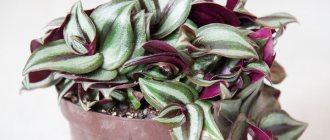Large leaves, tall flower stalks, decorated with bright butterflies - this is an orchid that is very difficult to care for at home. This foreign beauty came to us from the distant tropics and has long become the pride of many flower growers. Despite the clearly expressed heat-loving character and high maintenance requirements, she liked the local conditions. Of course, on the territory of our vast homeland, even in its warmest regions, it is only possible to grow orchids at home. While such flowers grow right under the canopy of trees in distant China or Australia, we can create tropics for them exclusively indoors. However, this is more than enough for orchids to grow and delight with their unique blooms.
On this topic:
Beauty from the tropics - aphelandra, home care...
Sep 6, 2020
One of the largest and most flowering dracaenas is the dracaena...
Sep 4, 2020
The ideal choice for lazy and busy gardeners is...
Sep 1, 2020
A luxurious flower for your flowerpot and more -...
Aug 28, 2020
BACK FORWARD 1 of 93
However, before you buy a lovely tropical flower, you should learn all about orchids at home. After all, in order for them to feel good, they should create conditions that are as close to natural as possible. Warmth, moisture, moderate lighting - that's what these beauties need. And, of course, it is also necessary to properly care for plants throughout their life, taking into account different periods of development.
Luxurious orchid - care at home, taking into account growing technology
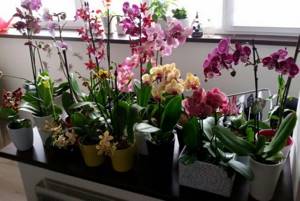
First of all, it is worth noting that there are many types and varieties of orchids. Some of them grow, like most plants, in the soil, while most are epiphytes and live on trees. They feed not with roots, but with leaves, through which they absorb life-giving moisture. This does not mean that orchids are rootless crops. They have them, but they only serve more to give the outlet stability. One of these representatives is phalaenopsis, the most popular home orchid among gardeners.
But regardless of the species, all orchids are heat-loving tropics that require special maintenance conditions.
The room where they are located should have:
- warm;
- damp;
- light, but without direct rays.
Comfortable temperature
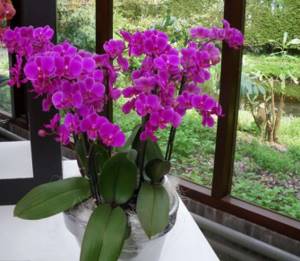
The room should have a stable above-zero temperature, preferably with a difference between day and night temperatures. Plants feel best at 23°C. Higher temperatures have a negative effect on them: they quickly dry out the substrate and reduce leaf turgor. At the same time, coolness is needed for the formation of buds. In order for an orchid to bloom annually, profusely and for a long time, at night the temperature must drop 5 - 8 ° lower.
On this topic:
We organize proper care for Howea Forster at home...
Aug 21, 2020
“Live” flower on your window - oxalis, care...
Aug 21, 2020
BACK FORWARD 1 of 182
Drafts and cold air flow from the air conditioner are destructive for flowers. First of all, the leaves suffer from them, becoming covered with spots. Then the orchid may die completely.
Air humidity
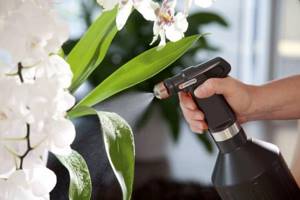
Orchids require high levels of air humidity, which is typical for the tropics. It is somewhat difficult to maintain it in an apartment, especially during the heating season. Therefore, plants must be sprayed frequently.
A special device - an air humidifier - will help maintain the desired humidity in the house.
This is especially convenient during the flowering period of orchids, because water should not get on the buds. Brown spots appear on them, which spoils the appearance. In addition, the flowers no longer last as long and fade quickly.
Orchid: care at home in compliance with the lighting regime
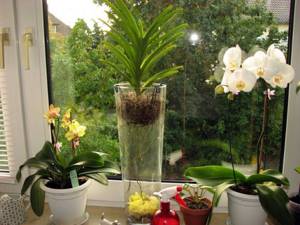
Tropical plants need indirect light. Since in nature orchids grow under the protection of tree crowns, they do not like direct rays. South-facing windows are completely unsuitable for these crops - they quickly “burn out” there. It is better to place the pot on western window sills. Oriental ones are also suitable, but on the condition that in the morning, when the sun is shining in them, the flowers will be shaded. In winter this is not so important, but the spring sun already burns well through the glass and causes burns.
In winter, on the contrary, the orchid needs additional lighting, especially if this period coincides with its flowering. If there is insufficient lighting, the buds may never open fully, and the foliage turns pale and yellow.
It is advisable to provide additional lighting to plants in the fall, starting in October, when daylight hours begin to decrease. In most species, it is during this period that the formation of flower buds occurs. If the orchid does not have enough light, it may not bloom. Accordingly, another main point in caring for an orchid at home is winter supplementary lighting.
In order for a flower stalk to appear at the end of winter, it is necessary to provide at least 10 hours of daylight.
Caring for an orchid after purchase
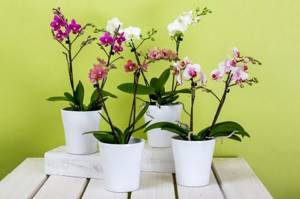
It is important to learn how to properly care for an orchid. Then the flower will only delight you.
Temperature, humidity and lighting
One of the main factors for the well-being of a plant is proper lighting. The orchid has quite “strict conditions”. It does not tolerate direct sunlight. This plant comes from the southern countries, and there is an abundance of greenery there, and the low orchid always gets partial shade. Therefore, if a flower is destined to live on the windowsill of a south-facing window, it can be separated from the glass with thin muslin, gauze, or even translucent paper such as tracing paper.
But you shouldn’t darken the place where the plant will live. In this case, it will stop blooming, stretch out, the leaves will begin to lose their rich color and turn pale.
A west or east window would work well During short daylight hours, it is advisable to illuminate the orchid with a fluorescent lamp, bringing the length of the daylight period to 12 hours.
Also, the correct temperature regime is especially important for the flower. During the day, it is desirable that the air in the room be heated to 24-26 C, at night the temperature should drop to 14-16 C. In the warm season, the flower can be kept on a loggia or garden plot. There, temperature changes will be ensured. In winter, the room where the orchid is located can be ventilated at night.
However, it is undesirable for cold air from the window to hit the flower.
In nature, orchids grow in tropical rainforests, so it is advisable to create similar conditions for them in the house. True, thanks to the care of the owners, the flowers receive enough moisture, both from the substrate and as a result of watering. Still, additional care is needed. Especially in winter, when the indoor air becomes excessively dry due to steam heating batteries. To achieve the required humidity, the batteries can be covered with a cloth soaked in water - for example, thick towels or blankets. You can also purchase special air humidifiers.
Watering the plant
It is a misconception that the soil in a pot with an orchid should be moist, almost wet, all the time. Among the varieties of this plant there are those that love water more and those that love less. But all orchids cannot tolerate stagnant moisture in the soil; their roots begin to rot.
Watering should be abundant in spring and summer, when the plant is gaining color, and directly when it is already blooming. In winter, the orchid is watered 1-2 times a week.
The best option for spring watering is the following: place the orchid pot in a container with warm water for 7-10 minutes. Or you can give the plant a short shower.
Soil requirements and replanting
Today it is not a problem to provide an orchid with ideal soil for it. There is a large selection in stores. Typically, the composition of the soil for an orchid includes: charcoal, expanded clay, polystyrene foam, crushed pine bark and sphagnum moss.
Then a new pot of sufficient size is selected. In many cases, clear containers with slots are the best option. You should also stock up on activated carbon, pruning shears, and settled water.
In order not to damage the roots during replanting, it is advisable to place the pot with the orchid in water - “soak” it, and after that carefully remove the plant.
Then you should carefully examine the root system. Rotten areas are cut off, the sections are dried, and sprinkled with crushed coal. If pests are noticed, the roots are treated with an insecticide.
Old leaves are also cut off at the root - those that have become limp and have lost their rich color.
The new pot should not be too large, otherwise the orchid will grow foliage instead of flowering.
First, a portion of the substrate is poured into the bottom of the pot. Then place the flower and add soil to the required amount. You can crush and compact the soil, but only slightly. After some time, the plant itself will “fix” itself in a new place.
Water the orchid 5-6 days after transplantation.
Feeding and fertilizer
Naturally, the plant needs feeding. There are special additives that the flower shop will recommend - for example, Bona Forte. Recommendations for use are given on the packaging. It is important to remember that you cannot overfeed a flower with the best of intentions.
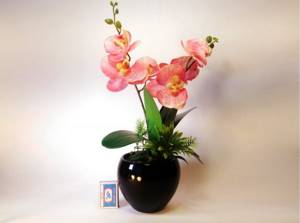
The plant should be fertilized in spring and summer; winter is a dormant period.
What soil is needed for an orchid?
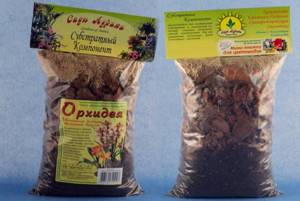
The composition of the soil depends entirely on the type of crop. As already mentioned, there are terrestrial and epiphytic varieties of orchids. Terrestrial species, such as cymbidium, naturally grow in the ground, so they also need soil at home.
It can be ordinary, but supplemented with useful additives that will give the orchid additional nutrition:
- rotted leaves;
- charcoal;
- peat.
Epiphytes require a special soil composition - they grow in the bark. Again, in nature, epiphytic orchids cling to the bark of trees with their aerial roots and grow on them. Therefore, home specimens should have similar conditions. Flower shops have a large selection of ready-made substrates specifically for orchids. For adult specimens, large-fraction bark is more suitable; young orchids need smaller fragments.
Orchids - epiphytes do not need nutritious soil. The main requirement for the soil is that it must quickly evaporate excess moisture.
Many gardeners prepare such soil mixtures on their own. The basis is store-bought ready-made soil for orchids.
Additional components are added to it to improve the structure and increase the looseness of the substrate:
- perlite;
- sphagnum;
- charcoal;
- expanded clay;
- oak or pine bark;
- husks from sunflower seeds.
Separately, it is worth mentioning about pots - for orchids it is better to use transparent plastic flowerpots. The roots are clearly visible in them and it is easy to determine when it is time to water the flower. And in case of rotting, it will be possible to notice the problem in time and prevent the death of the plant.
Ceramics for orchids is not the best choice, since the roots grow to the walls of the dish. During transplantation they are injured. If you really want to have a beautiful painted flowerpot, you can simply place a plastic pot with an orchid inside it.
Timing and cases of need for orchid transplantation
Since the soil for orchids is not a “food base”, but just a way to gain a foothold, these plants can be kept without replanting for a very long time. As long as the roots have room to grow and the pot remains stable, there is no need to replant the orchid.
The need for early transplantation arises only in emergency cases:
- the substrate and root system are infected with pathogenic microorganisms and the roots become sick;
- the substrate turned into dust, began to dry out poorly, become compacted and does not provide aeration to the roots.
If there is a need to transplant an orchid, it is advisable to do it after flowering has completed or before it begins. The best time is the phase of active growth of leaves and roots.
In emergency cases, when it is impossible to wait for the end of flowering, you will have to cut off the flower shoot before replanting. Firstly, the orchid will still drop its flowers. Secondly, without a peduncle, it will tolerate stress more easily.
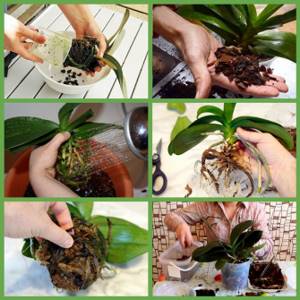
When transplanting, the root system is freed from the old substrate and washed. Dry and rotten roots are cut off and sprinkled with cinnamon or crushed activated carbon. After this, the orchid is placed in a new pot and filled with fresh substrate.
Orchid - home care for lush flowering
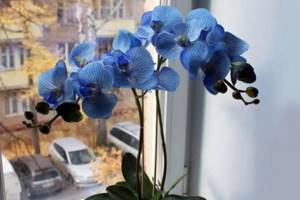
It is not enough to create tropics for orchids at home; it is also important to properly care for them. Especially in terms of watering, because providing moisture has its own characteristics. No less important is feeding flowers that grow in non-nutritious substrate. They receive all the necessary elements for development and flowering exclusively through feeding. And well-developed rosettes also require a larger pot so that they are not crowded. Don’t forget about this point: how to care for an orchid at home depends on its specific type. Terrestrial varieties have slightly different requirements than epiphytes.
On this topic:
Large-sized Tradescantia or reo flower - care for...
Large-sized palm tree for a spacious hall - areca, care in...
An unpretentious flower for a shady garden - loosestrife,...
Four proven methods of resuscitation if an orchid has rotted...
BACK FORWARD 1 of 92
How to water orchids
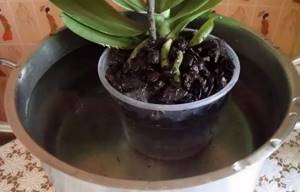
The thick gray roots in the pot and protruding above it are not really roots at all. Or rather, the roots themselves have the appearance of a thin but strong thread and are hidden precisely in this gray thickening. The spongy gray fabric is designed to absorb moisture and create reserves. It is she who feeds the filamentous roots, gradually releasing water. This determines the peculiarities of watering orchids. Despite the fact that they love moisture, its excess leads to rotting of the roots.
You should water orchids only after inspecting the contents of the flowerpot. If the roots are greenish, the pot is heavy and there are drops of condensation on its walls, there is enough moisture. Watering should be delayed until the roots become silver in color and the container is significantly lighter in weight. This means that the substrate has dried well and become light, and the moisture reserves in the spongy tissue have also been reduced to a minimum.
It is recommended to water orchids through a tray, immersing the pot in a bowl of lukewarm water.
In summer, when it is hot, the plants are watered more often, but not too much, so as not to flood them. In winter, the frequency of watering is reduced. But orchids love frequent spraying at any time of the year - this is another way for them to “get drunk.” In addition, as a result, air humidity increases, which only benefits the flowers.
How to fertilize plants
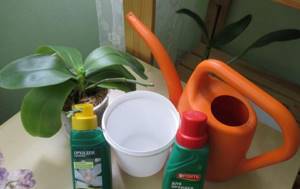
For orchids, it is necessary to use special liquid preparations that contain soluble mineral fertilizers. They are added to water when watering and spraying. To bloom profusely and for a long time, gorgeous beauties need phosphorus. To grow large foliage, they need nitrogen, and for metabolism and the formation of strong immunity - potassium. These are the three main components of any fertilizer, which have the required proportions. They vary depending on the purpose of application, for example, feeding flowering orchids or simply for growth. In addition to them, the preparations also contain other microelements that help the flower develop.
It’s not difficult to choose the right concentration, because there is a wide selection of fertilizers for orchids in stores.
For example, you can use one of the drugs that are in the photo below:
- Bona Forte;
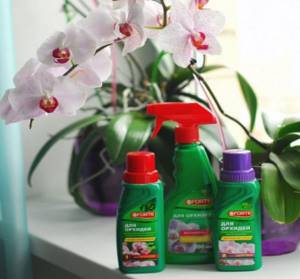
- Pokon;
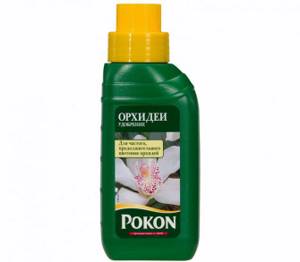
- Dr. Foley;
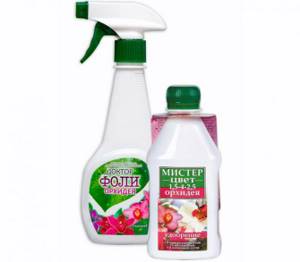
- Agricola;

- Agrecol.
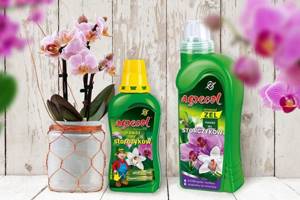
Orchids do not have a rest period, so they need feeding all year round. In autumn and winter, once a month is sufficient; in spring and summer, fertilizers should be applied twice a month.
When to replant
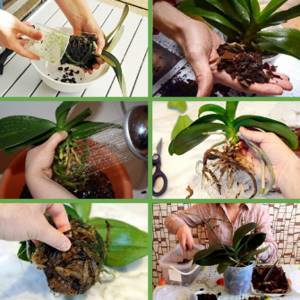
On average, an orchid can grow in one pot for 2 – 3 years. But during this time the outlet grows greatly and requires more space. If the flowerpot is entangled with aerial roots that hang down on the windowsill, it means the orchid needs a transplant. In addition to increasing the size of the plant, the need for replanting is also caused by a change in the structure of the substrate. Over the course of several years, the bark begins to deteriorate, and air exchange between the roots is disrupted.
Replanting an orchid is a little more difficult than ordinary plants that grow in the ground. This is due to the fact that the roots often grow together with the bark, it is difficult to detach them, and it is inconvenient to fill the pot tightly with fresh bark.
But with a little effort, you can do everything quickly and, most importantly, carefully:
- The first step is to remove the orchid from the pot. It comes out easily, but you need to hold it by the leaves.
- Clean the roots from the substrate and inspect them thoroughly.
- Cut off dry and rotten roots. Sprinkle the sections with crushed activated carbon.
- Place a layer of fresh substrate at the bottom of the new pot.
- Place the orchid in the center of the container, straighten the roots and cover with fresh bark. If necessary, use a pencil to push the pieces under the spine.
In case of orchid disease or root rotting, transplantation should be carried out immediately. All affected roots must be removed, and the remaining ones are treated with a fungicide.
What does an orchid need to bloom well?
In fact, there are no special secrets in this, you just need to choose the right location, provide longer daylight hours, water and feed it on time, and then it will definitely thank you with abundant flowering, which lasts from three to six months. But first things first…
Light
This factor largely determines whether the plant will bloom or not. If daylight hours last less than 10 hours, it is necessary to install an additional light source. If there is enough light, then the orchid will always be in flowers. Few hours of daylight affect leaf color changes. So gradually they stretch out and turn yellow.
There are several basic rules for light for orchids:
- Direct sun should not be allowed to penetrate; the window should be covered with white paper or matte film.
- Orchids love diffused light; this must be taken into account when caring for them;
- Extending daylight hours to 12 hours in autumn and winter (use of fluorescent light bulbs).
See also: “Why hydrangea doesn’t bloom, but only produces foliage”
Temperature
Many flower lovers are sure that orchids are exclusively tropical plants, but this is not so.
Cold-loving: laelia, paphiopedilum, Australian dendrobium. All these types of orchids grow in the mountains, where in summer the temperature does not exceed 21 degrees, and at night drops to 13 degrees.
Medium-temperature: odontoglossums, miltonia. It is extremely difficult to provide care for these plants in apartment conditions. Since in summer the temperature should not exceed 23 degrees, and at night 14.
Heat-loving: catley, phalaenopsis, dendrobiums, this group of plants always needs warmth. The temperature in summer varies from +17 +33 during the day to + 16 +19 at night.
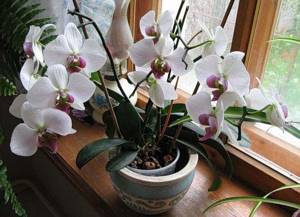
Watering
When purchasing a plant in a store, many people are concerned about whether it is necessary to water the orchid in the pot after purchase. Experts say from many years of experience that there is no need to water. After all, it is probably unknown when the store was watered. Therefore, they wait from 7 to 10 days. Transplantation is also undesirable, because the plant still needs to adapt to external conditions.
Orchid roots do not tolerate stagnant water, so watering should be done with caution. Phalaenopsis and paphiopedilium tolerate high humidity well, but oncidium and dendrobium like limited watering and only when the substrate is completely dry.
The peculiarity of orchids is that they tolerate drought more easily than excess moisture. Good watering is only necessary when the plant is ready to flower and has produced its first flower stalks. In winter, the orchid is practically not watered. For irrigation, use settled water at room temperature. The pot with the plant is placed in a container with prepared water for 10 minutes. And then they leave it on a special grill or in a bath to drain off all the excess moisture. They love orchids and warm showers.
Now you definitely can’t go wrong with moisture and will know how to water an orchid in a pot at home.
Top dressing
Additional nutrition for orchids is necessary only during active growth. In winter, orchids are not fed. Special mixtures for orchids are used as fertilizer. Microelements are diluted in strict accordance with the recommendations. Before feeding, the substrate must be well moistened.
The most optimal composition for planting orchids is pine bark. You can assemble it yourself or buy ready-made fractions. It is collected from fallen pine trees or directly around growing trees. Before placing the bark in a pot, it is boiled in water for thirty minutes, then dried well. It is necessary to put expanded clay at the bottom of the container and make holes for air penetration; there should be much more of them than for ordinary flowers.
Home care after buying an orchid
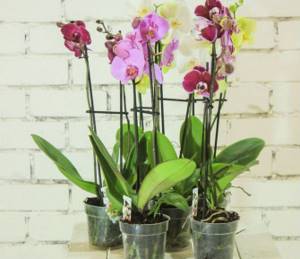
In flower shops, all their green inhabitants live in a completely different climate, different from that of an apartment. There is higher humidity, and stably maintained, optimal temperature and lighting. Therefore, an orchid “torn out” from its usual conditions and brought home experiences real stress. She needs time to adapt to both less bright light and lower humidity. And also - to make friends with your “neighbors”, but at the same time not to infect them with possible insects - pests or fungi. Not often, but it happens and even store-bought copies can get sick.
What to do with the purchased flower? First of all, the pot with the plant is quarantined for a couple of days, placing it separately from other indoor flowers. This should be a cozy place, maybe partial shade - for this period the lighting requirements are not so high. The main thing is that there is no working heating radiator nearby. Moreover, for the first 2 weeks it is advisable not to place the orchid near other plants at all.
The first watering after purchase is carried out after 7 - 10 days, then you can water once a week - one and a half. Otherwise, caring for an orchid at home is the same as described above.
Do I need to replant a purchased orchid? If it is healthy and there are no pests, there is also no need for replanting. This is additional stress for the flower.
Fertilizers
In the jungle, located on the treetops, the crop receives few nutrients, so at home, frequent feeding will not benefit the flower. Its roots are very sensitive to salt, and if there is an excess of fertilizers, they die.
An orchid can do without feeding at all: regular replanting into a new substrate is enough. If you still want to support the flower with additional nutrition, you can use special complex formulations. These include:
- nitrogen for foliage and shoots;
- phosphorus for roots and flowers;
- calcium for growth;
- potassium for disease resistance;
- magnesium for healthy metabolism.
Related article:
Why an orchid does not bloom and how to persuade it to send out a new arrow
When keeping an orchid at home, it is enough to feed it once every 2-4 weeks, while during the dormant period the amount of fertilizer should be reduced as much as possible. The nutrient mixture is added to the substrate only after watering, strictly observing the proportions specified in the manufacturer’s instructions.
An orchid is blooming: care at home should be special
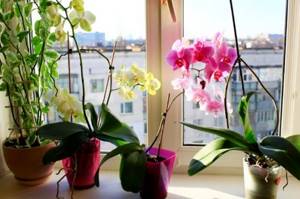
During the flowering period, orchids need special care and the creation of more comfortable living conditions. At this time they need more lighting, in addition, it is advisable to move the pot to a warmer room. But this must be done at the stage of formation of the peduncle, because it is impossible to rearrange the flowering bush.
During flowering, you cannot replant the orchid and spray its buds and flowers.
Blooming orchids need regular watering, so it is important not to let the substrate dry out completely. They also need feeding with special mineral complexes that will help prolong flowering.
Orchid propagation
Some varieties reproduce primarily by children, while others reproduce by simple division of growth points. It all depends on what kind of orchid, but all types can be propagated using seeds. Although at home this method is almost never used due to the labor-intensive and time-consuming process.
You can also propagate indoor orchids in this way:
- Division. Suitable for dendrobiums and other sympodial species that have many growing points. It is better to divide only very overgrown orchids, leaving at least 3 pseudobulbs on each division. Then the new plant will take root easier and bloom faster.
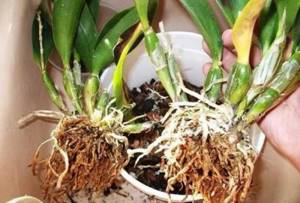
- Rooting of root children. To obtain them, the old plant is divided horizontally, leaving a trunk with several roots. There should also be a couple of leaves on the stalk that is left. Over time, basal children with their own roots form on it.
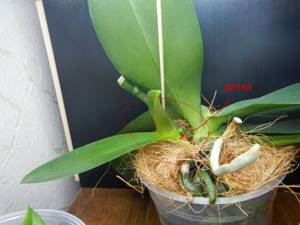
- Cuttings. It is noteworthy that all types of orchids can be taken from cuttings. Sympodials are propagated by cuttings of pseudobulbs, and monopodials by cuttings of peduncles.
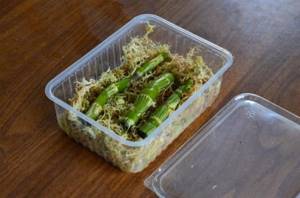
- Separation and rooting of children formed on the peduncle. They may appear on their own or they can be stimulated using hormonal paste.
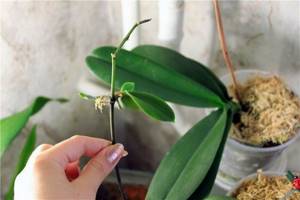
Sometimes you can find orchid bulbs on sale. They are actually pseudobulbs of a variety called cycnades. It is planted “standing” in dry bark, only slightly deeper, and is not watered until roots form.
Thus, orchids and caring for them at home are not such a difficult task. Knowing the specific development and requirements of these tropical plants, it is quite possible to please them. And in return, the orchids will delight you with gorgeous blooms.
